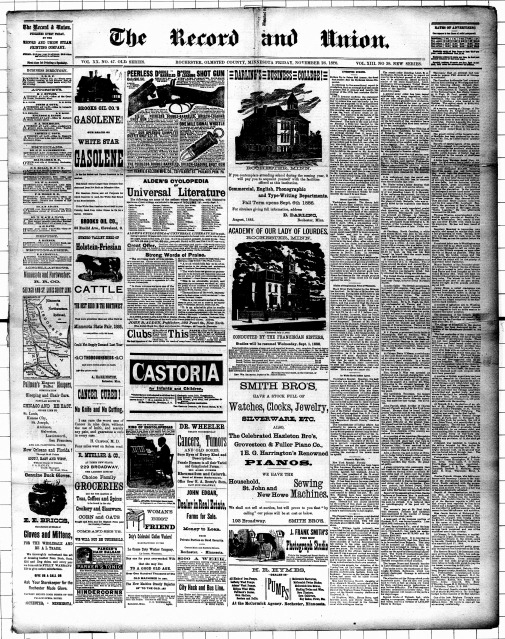Rochester Record and Union
Federal union (Rochester, Minn.) 1866-1874 Browse the title
Rochester semi-weekly central record (Rochester, Minn.) 1871 Browse the title
Rochester weekly central record (Rochester, Minn.) 1871-1872 Browse the title
The Minnesota record (Rochester, Minn.) 1872-1874 Browse the title
The record and union (Rochester, Minn.) 1874-1899 Browse the title
Daily record and union (Rochester, Minn.) 1893-1899 Browse the title
Rochester, Minnesota is situated in the southeastern corner of the state in the center of Olmsted County. Rochester was founded in 1854 by George Head. In 1856 the population was recorded as 50 people; but by 1858, thanks in part to rumors of a gold rush, the population topped 1,500 people. In 1856 Rochester was named County Seat of the newly established Olmsted County. In 1863, Dr. William W. Mayo came to Rochester as a medical examiner for draftees of the Civil War. The Mayo Clinic would come to define Rochester as a world-wide epicenter for medical care and research. The area surrounding Rochester was overwhelmingly agricultural, with a focus on dairy and grains.
The Rochester Record and Union was published in Rochester, Minnesota between the dates of 1874 and 1899. This weekly publication covered the growing town of Rochester and all of rural Olmsted County. The Record and Union was a combination of two earlier newspapers, the Federal Union and the Minnesota Record both published in Rochester.
The Federal Union, (1866-1874) under the direction H. S. Knapp, was a staunchly Democratic paper. This publication adopted the motto "Dedicated to the sovereignty of the States, and the Liberties of the People". This journal covered all things political in the state of Minnesota and the effect they had, or would have, on the people of Olmsted County.
On the other side of the spectrum was the Central Record which identified as an Independent-turned-Republican paper. The Weekly Central Record and Semi-weekly Central Record took a broad view of the news as it pertained to its customers covering many wide reaching topics. One column, "Farm, Garden and Dairy", certainly received many accolades from readers as it eventually overtook the entire 4th page of the publication. The two incarnations of the Central Record lasted from 1871 until 1872, when editor and owner Amherst W. Blakely changed the name to the more accurately descriptive Minnesota Record. The Minnesota Record continued publication for 2 years until 1874, at which point the paper merged with the Federal Union to create the Record and Union.
The Record and Union was fairly transparent in its language and declared an allegiance with the developing "reform" movement. The following excerpt is an example of how the Record and Union described its political priorities and its attempt to merge the two separate publications:
The FEDERAL UNION has been known and recognized as the ardent and earnest friend of the recently organized reform movement, … and has been the true friend of the agricultural and laboring classes from which all interior newspapers derive their main support.
The inaugural issue of the Record and Union lists Mr. Amherst W. Blakely and Mr. H. H. Young as editors, and M. A. Burbank as business manager. A good portion of the first issue is dedicated to explaining the merger of the Minnesota Record and the Federal Union. Much thought was put into the merging of the two separate papers. The editors, Blakely a Republican and Young a Democrat, went into great detail about the future of political reporting in the new publication, and assured readers that if they continued to subscribe that they would receive much the same views as they did in the separate papers.
An important story was the great tornado of 1883. Unlike many other papers that published the story on the front page, the Record and Union printed the story on the third page but does go into detail about the damage and injuries caused by the massive storm. The Record and Union covered regional, state and national news. Coverage focused on agricultural and working class activities and happenings that affected such activities. "Farm, House and Garden" was a column devoted to farm and home management, and included tips and resources for farmers and landowners. Early issues of the Record and Union also featured a few light hearted columns filled with poetry and fiction.
In 1886 Record and Union editor, Amherst W. Blakely, and his son, Clarence W. Blakely created the A. W. Blakely and Son Publishing Company, Inc. This company persisted until several years after the last issue of the Record and Union was published, when the company was reincorporated as Blakely Printing Company.
In 1899, under the leadership of Amherst Blakely, the Record and Union merged with the Rochester Post and Rochester Daily Post. The new publication dropped the ‘Union’ from the title and became the Post and Record and Daily Post and Record. The Blakely family, Amherst, David, and Clarence, were notable in that they oversaw a number of significant events in Minnesota publishing history, including the 1875 merger of the St. Paul Pioneer and the St. Paul Press to form the St. Paul Pioneer Press.
